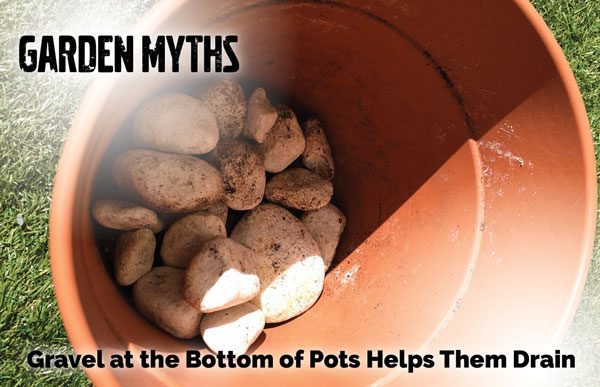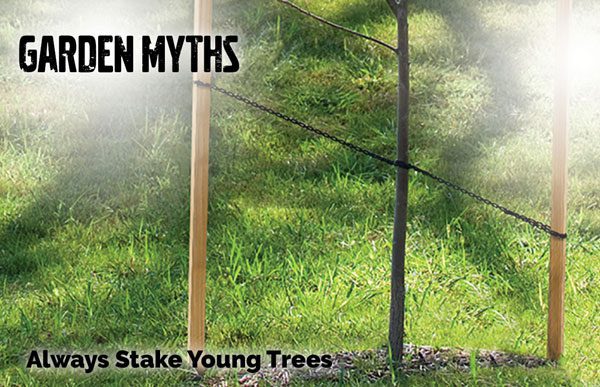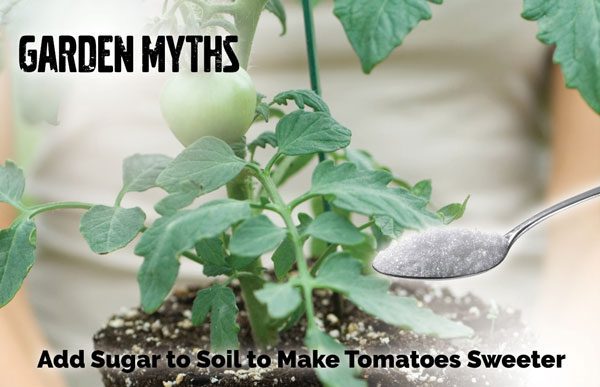Human beings love myths, words of wisdom that we believe, but no one knows if they’re true. There are so many “myths” out there that the Discovery Channel made a show out of testing them for 14 seasons! I’m not sure if the Mythbusters ever covered any of these, but here are five gardening myths that you can bust right now.
Gravel at the Bottom of Pots Helps Them Drain

This is one you hear a lot when potting plants. The idea is that the gravel allows air to move through, and having it at the bottom of your pot allows for better drainage. But when you think about it, does it make sense? The water still has to go through the soil to get to the bottom and is more likely to sit above the rocks. If your pot has a hole in the bottom, that’s all you need for water drainage. With the gravel at the bottom, you are taking away space for the roots to grow. If you want to improve drainage, mix some stones and sand into the soil while planting.
Always Stake Young Trees

It makes sense, right? Young trees are more delicate, and staking keeps them straight and sturdy in the elements as they grow and helps them develop a strong trunk. But by staking them, you’re stunting their strong growth potential.
Staking a tree means it doesn’t have to work as hard to stand tall and fight the wind. Just like how we need to work our muscles to make them bigger, staking a young tree for too long can cause it not to work it’s own “muscles” – resulting in a tall tree, but one with a skinnier trunk.
The response of trees and plants to wind is called thigmomorphogenesis. The fighting of the winds releases ethylene gas, a growth mediator that causes the formation of wood-strengthening lignin. If you must stake, do so for as short a time and as loosely as possible.
Add Sugar to Soil to Make Tomatoes Sweeter

I think this myth persists because we all want it to be true. How cool would that be if we could add sugar or spices to the soil and affect the flavor profile of the food grown? Unfortunately, it isn’t true. Sugar in the earth has zero effect on the sweetness of the tomatoes. What does affect sweetness is the type of tomato (genetics), and how much sun the plant gets.
Banana Peels and Coffee Grounds

These are two slightly different myths, but they both have the same problem, so I put them together. The first myth is that you should bury banana peels in the soil to provide extra potassium to roses. The second is that mixing coffee grounds into the soil around acid-loving shrubs helps lower the soil’s pH levels.
On the surface, both sound entirely plausible. Bananas do have lots of potassium, and roses (among other plants) do need such nutrients. And coffee grounds are acidic and can affect the pH of the soil. However, in both cases, the process required to break them down and decompose uses up a lot of the nitrogen in the ground, which means less nitrogen for the greening up of the plants themselves.
Organic Doesn’t Always Mean Safe

The idea behind organic gardening is excellent, and one that more and more people need to get behind. But just because you aren’t using pesticides doesn’t mean the alternative is much better. There are many products out there that use eye-catching labels touting their product as “natural,” but on closer inspection… maybe not!
You might see an organic product that is 20% vinegar. While this might be effective for your plants, it is also toxic for toads and frogs. Other products might contain copper. Sure, it can be called organic, but copper doesn’t break down. And as it builds up, it can be harmful. Then you have Pyrethrum. It’s all-natural, made from chrysanthemums, but it will also kill bumblebees and is toxic to pets and humans if not handled correctly. It comes down to not just relying on a big bright, “natural” or “organic” label. But instead, reading the ingredients and being aware of what you are using.